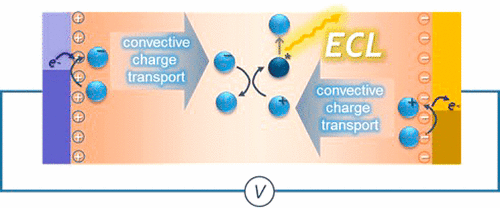当前位置:
X-MOL 学术
›
ACS Photonics
›
论文详情
Our official English website, www.x-mol.net, welcomes your feedback! (Note: you will need to create a separate account there.)
Light-Emitting Devices Based on Electrochemiluminescence: Comparison to Traditional Light-Emitting Electrochemical Cells
ACS Photonics ( IF 7 ) Pub Date : 2017-11-10 00:00:00 , DOI: 10.1021/acsphotonics.7b00864 Seok Hwan Kong 1 , Jong Ik Lee 1 , Seunghan Kim 1 , Moon Sung Kang 1
ACS Photonics ( IF 7 ) Pub Date : 2017-11-10 00:00:00 , DOI: 10.1021/acsphotonics.7b00864 Seok Hwan Kong 1 , Jong Ik Lee 1 , Seunghan Kim 1 , Moon Sung Kang 1
Affiliation

|
Electrochemical processes can be exploited to operate light-emitting devices with unusual functionality. For example, light-emitting electrochemical cells (LECs) contain a small amount of electrolyte within the organic/polymer light-emitting active layer. The electrolyte in the active layer allows the multiple charge injection layers that are deemed critical for organic light-emitting diodes to be avoided. Very recently, an alternative light-emitting device platform based on electrochemical processes was also suggested. These devices rely on electrochemiluminescence (ECL), a light-emission process based on the charge transfer reaction between reduced and oxidized forms of luminophores. Although the ECL process has been extensively investigated in the field of analytical chemistry, its utilization in electronic devices is a new approach that offers unique opportunities. Despite the interesting opportunities, a good introduction to the subject is not available, particularly with a focus on electronic device applications. Moreover, the operation of ECL devices is often confused with that of LECs, even though they follow distinct working principles. This confusion occurs mainly because the active layers for both ECL devices and LECs contain light-emitting material and electrolyte material (although their compositions are completely different). Therefore, clarifying the difference between the two sister devices would be both necessary and useful. In particular, a comparison of the two sister devices would highlight the unique opportunities for ECL devices and inspire researchers to devise a novel light-emitting device platform, which is the primary goal of this perspective.
中文翻译:

基于电化学发光的发光器件:与传统发光电化学电池的比较
可以利用电化学过程来操作具有异常功能的发光设备。例如,发光电化学电池(LEC)在有机/聚合物发光活性层内包含少量电解质。活性层中的电解质可以避免被认为对有机发光二极管至关重要的多个电荷注入层。最近,还提出了基于电化学过程的替代发光器件平台。这些设备依靠电化学发光(ECL),这是一种基于还原和氧化形式的发光体之间的电荷转移反应的发光过程。尽管在分析化学领域对ECL工艺进行了广泛的研究,它在电子设备中的利用是一种提供独特机会的新方法。尽管有很多有趣的机会,但仍无法获得对该主题的良好介绍,尤其是侧重于电子设备应用程序。此外,即使ECL设备遵循不同的工作原理,它们的操作也常常与LEC的操作混淆。造成这种混乱的主要原因是ECL器件和LEC的有源层都包含发光材料和电解质材料(尽管它们的成分完全不同)。因此,弄清两个姐妹设备之间的差异既必要又有用。特别是,将这两种姐妹设备进行比较将突出显示ECL设备的独特机会,并激发研究人员设计出新颖的发光设备平台,
更新日期:2017-11-11
中文翻译:

基于电化学发光的发光器件:与传统发光电化学电池的比较
可以利用电化学过程来操作具有异常功能的发光设备。例如,发光电化学电池(LEC)在有机/聚合物发光活性层内包含少量电解质。活性层中的电解质可以避免被认为对有机发光二极管至关重要的多个电荷注入层。最近,还提出了基于电化学过程的替代发光器件平台。这些设备依靠电化学发光(ECL),这是一种基于还原和氧化形式的发光体之间的电荷转移反应的发光过程。尽管在分析化学领域对ECL工艺进行了广泛的研究,它在电子设备中的利用是一种提供独特机会的新方法。尽管有很多有趣的机会,但仍无法获得对该主题的良好介绍,尤其是侧重于电子设备应用程序。此外,即使ECL设备遵循不同的工作原理,它们的操作也常常与LEC的操作混淆。造成这种混乱的主要原因是ECL器件和LEC的有源层都包含发光材料和电解质材料(尽管它们的成分完全不同)。因此,弄清两个姐妹设备之间的差异既必要又有用。特别是,将这两种姐妹设备进行比较将突出显示ECL设备的独特机会,并激发研究人员设计出新颖的发光设备平台,



























 京公网安备 11010802027423号
京公网安备 11010802027423号